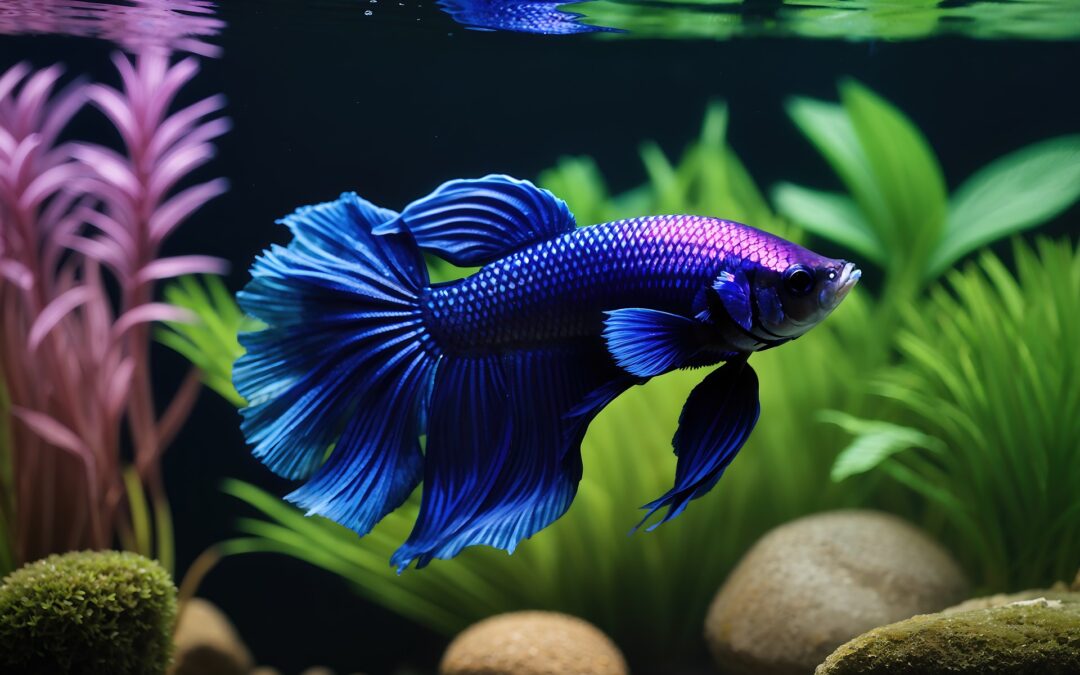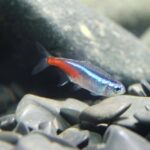Betta fish, known for their vibrant colors and flowing fins, thrive in a well-decorated and enriched environment. Plants, whether live or artificial, are not only visually appealing but also beneficial for your betta’s health and happiness. They provide shelter, help replicate a betta’s natural habitat, and can even improve water quality.
In this comprehensive guide, we’ll explore the best plants for betta fish tanks, including live and artificial options, how to care for them, and why they’re essential for your betta’s well-being.
Why Are Plants Important in a Betta Fish Tank?
Plants play a significant role in maintaining a healthy and natural environment for betta fish. Here’s why they’re essential:
- Hiding Spots: Betta fish are naturally territorial and sometimes shy. Plants provide safe hiding spaces where they can retreat and feel secure.
- Resting Areas: Bettas love to rest on broad leaves or float among foliage during naps.
- Water Quality Improvement: Live plants absorb harmful nitrates and carbon dioxide while releasing oxygen, promoting a balanced ecosystem.
- Aesthetic Appeal: Plants enhance the visual appeal of the tank, making it more enjoyable for both you and your fish.
- Stress Reduction: A tank filled with plants mimics a betta’s natural habitat, reducing stress and encouraging natural behaviors.
Best Live Plants for Betta Fish
Live plants are an excellent choice for betta tanks, offering natural beauty and functional benefits. Below are some of the best live plants for bettas:
1. Java Fern
- Scientific Name: Microsorum pteropus
- Care Level: Easy
- Light Requirement: Low to moderate

Java fern is a hardy, beginner-friendly plant perfect for betta tanks. Its broad leaves provide resting spots, and it thrives in low-light conditions. It can be attached to driftwood or rocks, making it versatile for aquascaping.
2. Anubias
- Scientific Name: Anubias barteri
- Care Level: Easy
- Light Requirement: Low
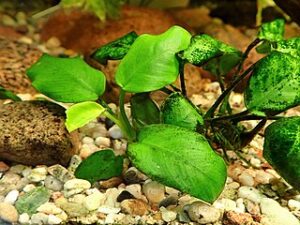
Anubias plants are slow-growing with thick, sturdy leaves ideal for bettas to perch on. Like Java fern, Anubias should be attached to hardscape rather than planted in the substrate.
3. Marimo Moss Balls
- Scientific Name: Aegagropila linnaei
- Care Level: Very easy
- Light Requirement: Low
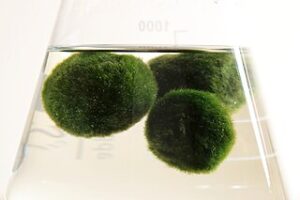
These soft, round “plants” are actually a type of algae and make a unique addition to betta tanks. They improve water quality by absorbing nitrates and are perfect for bettas to nudge or rest against.
4. Amazon Sword
- Scientific Name: Echinodorus amazonicus
- Care Level: Moderate
- Light Requirement: Moderate

Amazon swords are large, leafy plants that create a lush, jungle-like environment. They require nutrient-rich substrate and moderate lighting, but their expansive leaves offer excellent hiding and resting spots.
5. Cryptocoryne
- Scientific Name: Cryptocoryne wendtii
- Care Level: Easy to moderate
- Light Requirement: Low to moderate

Commonly called “crypts,” these plants are known for their wavy, colorful leaves. They grow well in low-light conditions and are ideal for foreground or midground planting in a betta tank.
6. Water Wisteria
- Scientific Name: Hygrophila difformis
- Care Level: Easy
- Light Requirement: Moderate

Water wisteria grows quickly and provides dense foliage for hiding and exploration. It can be planted in the substrate or left floating, offering flexibility in aquascaping.
7. Duckweed
- Scientific Name: Lemna minor
- Care Level: Easy
- Light Requirement: Moderate

Duckweed is a floating plant that mimics the betta’s natural habitat, providing shade and shelter. However, it grows rapidly and may need regular trimming to prevent overgrowth.
8. Hornwort
- Scientific Name: Ceratophyllum demersum
- Care Level: Easy
- Light Requirement: Low to moderate
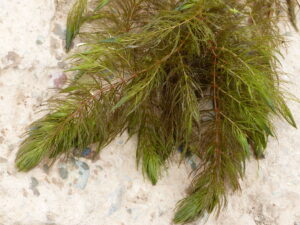
Hornwort is a fast-growing plant that can be planted or left floating. Its feathery leaves provide a safe haven for bettas, and it helps improve water quality by absorbing excess nutrients.
Best Artificial Plants for Betta Fish
If you prefer the low-maintenance option, artificial plants can be a great alternative. However, it’s important to choose betta-safe materials to avoid fin damage.
1. Silk Plants
Silk plants are soft and won’t harm your betta’s delicate fins. They come in various shapes, sizes, and colors, offering the aesthetic benefits of live plants without the care requirements.
2. Betta Hammocks
Specialized silk plants designed as hammocks provide a resting spot near the surface for bettas. These are functional and add a fun element to the tank.
3. Plastic Plants (With Caution)
Some plastic plants are safe for bettas if they have smooth edges. Always check for sharp or rough parts that could tear your betta’s fins.
How to Care for Live Plants in a Betta Tank
Caring for live plants ensures they thrive and continue to benefit your betta tank. Here are some tips:
1. Choose the Right Substrate
Plants like Amazon swords and Cryptocoryne need a nutrient-rich substrate, while plants like Java fern and Anubias can attach to hardscape.
2. Provide Adequate Lighting
Use aquarium lights suited for the specific plants in your tank. Most betta-friendly plants thrive in low to moderate light.
3. Use Fertilizers (If Needed)
Liquid fertilizers can provide essential nutrients for plants, especially in tanks without nutrient-rich substrate. Ensure the fertilizer is fish-safe.
4. Monitor Growth
Trim plants regularly to prevent overgrowth, which can reduce swimming space and block light.
5. Prevent Algae Overgrowth
Maintain a balance between lighting and nutrients to avoid excessive algae growth, which can harm plants and reduce water quality.
Common Challenges with Plants in Betta Tanks
- Plant Decay: Yellowing or melting leaves may occur due to inadequate lighting, poor water quality, or nutrient deficiencies. Address these issues promptly.
- Algae Growth: Overexposure to light or excess nutrients can lead to algae problems. Introduce algae-eating snails or reduce light exposure to control it.
- Betta Interaction: Some bettas may nibble on plants. While this is generally harmless, ensure no toxic plants are introduced.
How to Arrange Plants in a Betta Tank
Designing your betta tank with plants involves strategic placement for both aesthetics and functionality.
1. Foreground
Use small plants like Cryptocoryne or Marimo moss balls to create a neat foreground.
2. Midground
Place medium-sized plants like Java fern or Anubias to provide structure and resting areas.
3. Background
Tall plants like Amazon swords or Water wisteria make excellent background additions, creating depth and hiding filtration equipment.
4. Floating Plants
Add duckweed or frogbit for surface cover. These provide shade and mimic a natural habitat.
Live Plants vs. Artificial Plants: Which Is Better?
Both live and artificial plants have pros and cons.
Live Plants
- Pros: Improve water quality, create a natural environment, and provide oxygen.
- Cons: Require maintenance, lighting, and substrate.
Artificial Plants
- Pros: Low maintenance, available in various designs, and don’t require specific conditions.
- Cons: Don’t improve water quality and may harm fins if made from rough materials.
For a balanced tank, consider combining both types.
Conclusion
Choosing the best plants for your betta fish tank not only enhances its appearance but also promotes your fish’s well-being. Whether you opt for lush live plants like Java fern and Amazon swords or low-maintenance silk plants, the right choice depends on your time, experience, and preferences.
By creating a plant-rich environment, you’ll provide your betta with a comfortable, stimulating home that mimics its natural habitat. With proper care and planning, your tank can become a thriving underwater haven for your betta to explore, hide, and rest.
Your betta deserves the best—so start planting!

